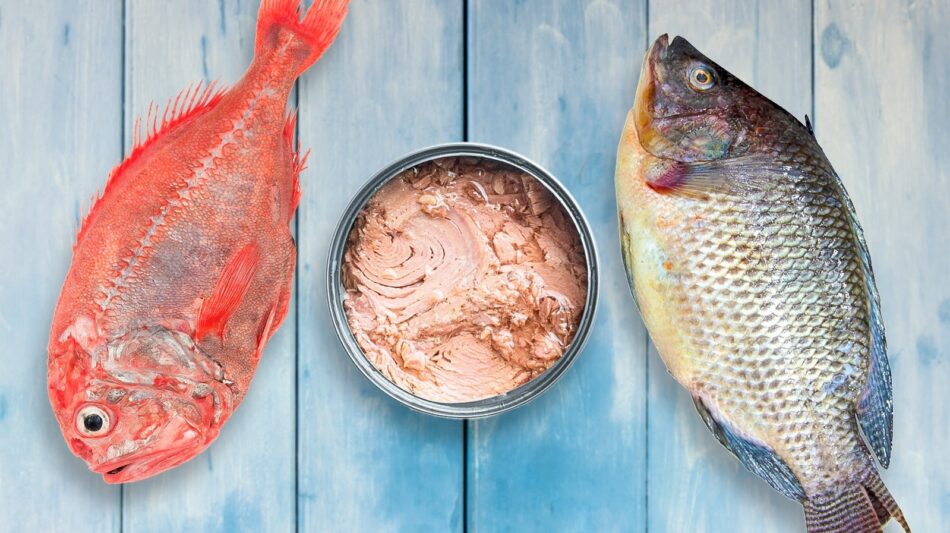We may receive a commission on purchases made from links.
There’s a lot to like about fish. It’s tasty and versatile, many varieties offer high-quality lean protein, and even fatty fish provide healthy omega-3 fatty acids instead of the saturated fats found in red meats. That’s why the current Dietary Guidelines for Americans suggest having fish (or seafood) twice a week.
Of course, that simple description of “fish” covers a lot of territory. Some are cheap, while some command a hefty price. Some are farmed or harvested sustainably, while others come with unadvertised baggage in the form of unsustainability or poor working conditions. Some are healthier, while others just plain taste better.
As a trained chef from Canada’s seafood-centric East Coast (and the descendant of a long line of fishermen), I’ve spent a lot of my life cooking fish, and also writing, researching, and thinking about how it’s raised and harvested. That means I’ve reluctantly ruled out a lot of inexpensive, otherwise-appealing kinds of fish for one or another of the reasons given above. Here are 10 common low-priced options, and why I suggest avoiding them.
Asian catfish
Catfish is one of America’s longstanding favorites, especially in the Southern states. And deservedly so, because it’s good stuff. Mostly it’s eaten breaded and fried, which isn’t exactly a strong endorsement of the “fish is healthy” argument, but it’s a versatile choice that can be cooked in many other ways if you choose to do so.
American catfish is a safe, practical, and reasonably priced product. It may be wild-caught or farmed, but all commercially sold catfish of U.S. origin are good choices. American catfish farms adhere to industry-standard best practices, and wild-caught blue cats from Chesapeake Bay are harvested in a responsible and sustainable fashion.
Sadly, that’s not reliably the case for Asian catfish. They’re from a related species, pangasius, but they can’t legally be sold as “catfish” in the U.S. because that label is reserved for domestic species. Instead, you’ll see it sold as swai, basa, tra, and a few other names. Consumers should avoid options that come from Vietnam or China because of heavy chemical use (and the associated health and environmental issues) in their farming process.
Pink or Keta salmon
You may be surprised to see salmon on a list of “cheap fish,” because it’s not generally among the cheapest offerings at your local store’s seafood section. That’s especially true of premium wild-caught Pacific salmon, which fetches a correspondingly serious price.
That said, there are several types of salmon out there, and not all of them are necessarily premium products. In fact, there are two that typically fall into the low-priced category, largely because they are kind of disappointing as salmon goes. One is Keta salmon, often known as chum or dog salmon, because in the past it was used for feeding sled dogs. The other is pink salmon, a small and very common Pacific species (your canned salmon will usually be pink, unless the label specifies otherwise).
You’ll often find these as fillets or even whole fish in the freezer section of your supermarket, where they’re the lowest-cost salmon option. Don’t get me wrong, it’s not that they’re in any way bad. U.S.-caught Keta and pinks make a decent meal, but they’re leaner and less flavorful than other salmon species, and therefore prone to coming out dry and overcooked. Overall, it’s usually worth spending a bit more to get a tastier variety.
Non-certified tilapia
Over the past couple of decades, tilapia has gone from being a relative novelty at the seafood counter to one of the most widely available and inexpensive choices. You’ll find tilapia recipes everywhere, including this site, and there’s definitely a recipe for every taste.
And yet, despite tilapia’s popularity, it’s hard to find anyone who’s really enthusiastic about it. Recipe writers and chefs speak of it as a blank slate for cooking with, which is a polite way of saying it’s pretty flavorless. The FDA calls it one of the best fish to eat, but that’s purely on the narrow basis of it being low in mercury. Like most fish, it’s a good protein source, but it’s low in the healthy omega-3 fatty acids that fish are prized for.
So far, I’ve made the case that it’s mediocre, not that it’s bad. What earns tilapia a place on this list is the often-dubious quality of its farming. Tilapia from countries such as Colombia, Indonesia, or Taiwan, or countries that have earned certification from one of the industry’s recognized certification bodies, is okay to buy if that’s your thing. Tilapia farmed in China should be avoided because of environmental and potential health issues.
Canned tuna
This one may feel like a gut-punch for a lot of you, and I totally get it. Canned tuna is a reliable pantry staple, something we’ve all leaned on for generations as an inexpensive ingredient for quick and easy meals.
So before you panic, I’m not suggesting that you stop buying it entirely, just that you should always read the label on canned tuna and know what you’re getting. There are two reasons why I say this. One is that tuna, even the smaller species, is a predator that tends to accumulate mercury in its tissues. That can cause health issues in humans, and it’s especially harmful for fetal development and in children, where their growing brains can be affected.
A second reason comes down precisely to tuna’s popularity. This has created significant pressure on wild populations of tuna, and also impacts other species that are caught as “bycatch” of the tuna industry. Look for canned tuna that names its species on the label (skipjack has lower mercury levels than albacore or yellowfin, for example), and brands that carry certification logos from one of the major certification bodies, like the Marine Stewardship Council. Those are harvested responsibly, with minimal impact on other species.
Orange roughy
Orange roughy is a niche product, compared to fish like salmon, tuna, and tilapia, but it’s still a common and popular choice in some regions. It isn’t as cheap as it used to be, but if you see it in stores, it may still be one of your more economical options.
Unfortunately, while it’s tasty and relatively affordable, this isn’t a fish you should buy frequently. Unlike the commonly-farmed tilapia, which comes to harvest with a speed that rivals factory-bred meat chickens, orange roughy is a long-lived and slow-reproducing fish. That’s not a combination that favors sustainability, because fish with those characteristics are extremely vulnerable to fishing pressure. Roughy fisheries also take place in environmentally sensitive areas, where their impact is yet unknown and hard to gauge.
Generally, roughy should be avoided because of environmental issues. It’s also worth noting that as a long-lived predator species, roughy accumulates a lot of mercury in its tissues. In fact, it’s one of the species highest in mercury, according to the FDA, so it should be avoided on that basis alone.
Atlantic cod
Cod was once a universal staple fish of the blue-collar world, whether fresh, dried, or salted. Mark Kurlansky’s award-winning 1989 book is called “Cod: A Biography of the Fish that Changed the World,” and he’s not wrong.
You won’t see a lot of Atlantic cod out there anymore, and there’s a reason for that: Although generations — centuries! — of fishermen had considered them to be inexhaustible, but by 1992, the cod population had utterly collapsed. It was a cautionary tale that still reverberates today, especially along the coasts of New England and Atlantic Canada, where our lifestyle was largely built around the fishery. Generations of my own family had fished cod, including (very briefly) myself, in the late 1970s.
Today, only a very few, small-scale sources of Atlantic cod are good options, and personally, I don’t buy even those because every fish landed, even in responsible and closely-managed fisheries, still diminishes the remaining gene pool. For your favorite cod recipes, choose Pacific cod, or East Coast alternatives like haddock or ling.
Tilefish
If you’re a saltwater angler, you may already have a fond acquaintance with tilefish. They’re a fun fish to catch, with adult specimens averaging around 15 pounds and occasionally getting to 50 pounds or more.
They’re also a great fish for eating. They’re moist and flaky, like grouper or snapper, but with an unusual, subtle sweetness that reminds some diners of crab or scallops. Even if you don’t get out to fish for your own, tilefish can often be found at your local fishmonger for a price that’s quite reasonable considering its culinary virtues. So why would you want to avoid such a tasty, pleasing fish?
Well, it’s that “m-word” again. As a large deep-water predator, tilefish tend to accumulate a lot of mercury in their tissues. In fact, in two decades of testing by the FDA, tilefish from the Gulf of Mexico had the highest levels of mercury contamination found in any fish species. Levels were lower in Atlantic-caught tilefish, so feel free to indulge in that occasionally if you’re not pregnant or nursing, but there are definitely safer options for your money.
Winter skate
It pains me to write this because I’m a big fan of skate, and I consider it to be an unfairly overlooked seafood option on our side of the Atlantic. Skate are flat, diamond-shaped fish rather like rays, and usually what you’ll see in fish stores are the so-called “wings.”
I’ve enjoyed skate for years whenever I could find it, because it’s a great fish to cook. A slab of “wing” gives you two large fillets, one above and one below a dividing line of rib-like cartilage (like sharks, skate have no bones). It’s delicious, and once cooked, it’s easy to slide the flesh from the cartilage for serving. So why is it on this list?
Well, there are a couple of reasons. One is that — again, like shark — because of its unusual physiology, skate breaks down quickly when it’s not absolutely fresh, and produces an ammonia-like aroma if it is handled incorrectly. More importantly, winter skate, which has seen significant growth in popularity, should be avoided except for a few specific certified fisheries. Populations are just too low, and skate is a slow-maturing species. Also, a number of less-exploited skate species only avoided being listed as endangered because there simply wasn’t enough data, which doesn’t exactly inspire confidence.
Farmed Coho salmon
Let’s finish up by circling back to salmon. As I mentioned earlier, there are a handful of Pacific species you can choose from, as well as farmed Atlantic salmon, and a limited quantity of wild Atlantic salmon from Europe.
I’ve already suggested that you give pink and Keta salmon a miss because of their modest quality. Sockeye and king (aka Chinook) salmon, and European salmon, are pricey and in the latter case often hard to find. That leaves farmed Atlantic and Coho as the value options when you’re shopping for salmon, giving you lots of flavor and heart-healthy omega-3s, without breaking the bank. Of the two, wild-caught Coho generally commands a higher price.
Over the past few years, you may have noticed that farmed Coho salmon has begun to appear in your local store at a price that competes directly with farmed Atlantic salmon for value. Unfortunately, while you can find certified or responsibly farmed Atlantic salmon from many sources, the farmed Chilean Coho should be avoided. The operators of those farms have a history of escapes, which has led to Coho naturalizing and threatening native species and the local ecosystem.









